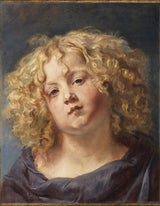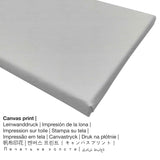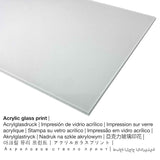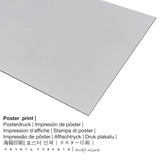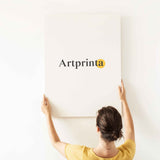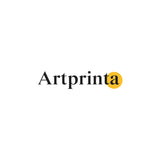Thomas Willeboirts Bosschaert, 1645 - Ọmụmụ isi nwata - mbipụta nka mara mma.
Ụtụ gụnyere. Mbupu gbakọrọ na ndenye ọpụpụ.
Onyinye ngwaahịa
This more than 370 years old painting was painted by the Baroque onye na-ese ihe Thomas Willeboirts Bosschaert. The artwork measures the following size Ogologo: 37,5 cm (14,7 ″); Obosara: 29,3 cm (11,5 ″) Ekebere: Elu: 57,5 cm (22,6 ″); Obosara: 50 cm (19,6 ″); Omimi: 8 cm (3,1 ″). What is more, this artwork is included in the art collection of Nationalmuseum Stockholm. With courtesy of: Nationalmuseum Stockholm na Wikimedia Commons (nwere ikike - ngalaba ọha).Also, the work of art has the following creditline: . Further, the alignment is Eserese ma nwee oke onyonyo nke 3: 4, nke pụtara na ogologo bụ 25% mkpụmkpụ karịa obosara. The painter Thomas Willeboirts Bosschaert was an artist, whose style was mainly Baroque. The artist lived for a total of 41 years and was born in 1613 in Bergen op Zoom and died in 1654.
Họrọ ihe kacha amasị gị
Maka mbipụta nka ọ bụla anyị na-enye nha na ihe dị iche iche. Nhọrọ ndị a dị maka n'otu n'otu:
- Mbipụta kanvas: The UV printed canvas stretched on a wood frame. A canvas makes a sculptural impression of three-dimensionality. Canvas Prints have the advantage of being low in weight. This means, it is easy and straightforward to hang up the Canvas print without any wall-mounts. A canvas print is suitable for any kind of wall.
- Mbipụta akwụkwọ mmado (ihe kwaaji): Our poster print is a printed flat canvas paper with a slightly roughened surface texture, which reminds the original artwork. It is particularly used for putting your art print in a personal frame. Please bear in mind, that depending on the size of the canvas poster print we add a white margin between 2-6 cm round about the print to facilitate the framing with your custom frame.
- Mbipụta nke aluminom: These are metal prints on aluminium dibond material with an impressive depth - for a modern look and a non-reflective surface. Colors are luminous and vivid in the highest definition, the fine details appear crisp and clear.
- Mbipụta iko acrylic (nke nwere ezigbo mkpuchi iko): An print on acrylic glass, which is sometimes referred to as a print on plexiglass, will turn an artwork into amazing décor. The real glass coating protects your chosen art replica against light and external influences for between 40-60 years.
Important information: We try whatever we can to describe our products in as much detail as possible and to exhibit them visually. Please bear in mind that the colors of the print products and the imprint can vary marginally from the image on the screen. Depending on your settings of your screen and the quality of the surface, not all colors will be printed one hundret percent realistically. Considering that all our are processed and printed by hand, there may as well be slight variations in the motif's exact position and the size.
Banyere edemede a
| Nkewa edemede: | nka nka |
| Mmeputakwa: | dijitalụ mmeputakwa |
| Production usoro: | mbipụta dijitalụ |
| Ihe ngosi: | German mere |
| Stockdị ngwaahịa: | mmepụta ihe na-achọ |
| Ojiji ngwaahịa: | ime ụlọ, ihe ndozi ụlọ |
| Ndozi onyonyo: | nhazi ihe osise |
| Oke akụkụ onyonyo: | 3: 4 (ogologo: obosara) |
| Ihe: | ogologo bụ 25% mkpụmkpụ karịa obosara |
| Nhọrọ akwa: | mbipụta ọla (aluminium dibond), mbipụta akwụkwọ mmado (akwụkwọ kwaaji), mbipụta kanvas, mbipụta iko acrylic (nwere ezigbo mkpuchi iko) |
| Ọdịiche dị n'okirikiri akwa akwa akwa (akwa akwa): | 30x40cm - 12x16", 60x80cm - 24x31", 90x120cm - 35x47", 120x160cm - 47x63" |
| Mpempe iko acrylic (nwere ezigbo mkpuchi iko) nha: | 30x40cm - 12x16", 60x80cm - 24x31", 90x120cm - 35x47", 120x160cm - 47x63" |
| Mbipụta akwụkwọ mmado (akwụkwọ kwaaji): | 30x40cm - 12x16", 60x80cm - 24x31", 90x120cm - 35x47" |
| Nha ebipụta aluminium dibond: | 30x40cm - 12x16", 60x80cm - 24x31", 90x120cm - 35x47" |
| Nhazi mmeputa nka nka: | oyiri nka na-enweghị isi |
Nkọwa gbasara ọrụ nka pụrụ iche
| Aha ọrụ nka: | "Study of a Boy's Head" |
| Nhazi nka: | sere |
| Otu izugbe: | nka ochie |
| oge: | 17th narị afọ |
| Afọ nka: | 1645 |
| Ogologo afọ nka nka: | gbara afọ 370 |
| Nha izizi nka: | Ogologo: 37,5 cm (14,7 ″); Obosara: 29,3 cm (11,5 ″) Ekebere: Elu: 57,5 cm (22,6 ″); Obosara: 50 cm (19,6 ″); Omimi: 8 cm (3,1 ″) |
| Egosiputara na: | National Museum nke Stockholm |
| Ebe ngosi nka: | Stockholm, Obodo Stockholm, Sweden |
| Webụsaịtị ihe ngosi nka: | www.nationalmuseum.se |
| Akwụkwọ ikike nka: | ngalaba ọha |
| Site n'aka: | Nationalmuseum Stockholm na Wikimedia Commons |
Ose okwu
| aha: | Thomas Willeboirts Bosschaert |
| okike onye nka: | nwoke |
| Ọrụ: | onye na-ese ihe |
| Nkewa onye nka: | nna ukwu ochie |
| Ụdị nke onye na-ese ihe: | Baroque |
| Afọ ọnwụ: | 41 afọ |
| Amụrụ n'afọ: | 1613 |
| Ebe omuma: | Bergen op Zoom |
| Afọ ọnwụ: | 1654 |
| Obodo ọnwụ: | Antwerp |
© echebe nwebiisinka | Artprinta.com
Additional specifications by the museum's website (© Copyright - Nationalmuseum Stockholm - National Museum nke Stockholm)
English: Acquisition of the Month, September 2015 An Oil Study by Thomas Willeboirts Bosschaert Nationalmuseum’s collection of Baroque paintings has been enriched by a work by Flemish painter Thomas Willeboirts Bosschaert. The painting is an oil head study of a mischievous-looking boy with rosy cheeks and abundant curly blond hair, painted in the mid-1640s. Leaning back slightly, his head cocked to one side, the model meets the viewer’s glance with curiosity, but also with reserve. Probably, this is a so-called tronie, a preparatory study intended to be used for many different compositions. The boy was, for example, used as a model for the god of love in the allegorical painting of Amor Triumphant Amongst the Emblems of Art, Science and War, painted circa 1645 in collaboration with the still-life painter Paul de Vos. The latter work formed part of the art collection of Swedish Queen Lovisa Ulrika in the 18th century and now belongs to Nationalmuseum. Thomas Willeboirts Bosschaert (1613-1654) was apprenticed to the history painter Gerard Seghers at Antwerp. In 1637 Willeboirts became a master in Antwerp’s Guild of St. Luke as was also awarded his citizenship. Shortly thereafter, he received an invitation by the city’s leading, internationally renowned painter Peter Paul Rubens, to collaborate on a series of paintings commissioned by the Spanish king Philip IV for his hunting lodge, the Torre de la Parada. Despite his close collaboration with Rubens, the most important source of inspiration for Willeboirts was the work of the younger artist Anthony van Dyck. Indeed, Willeboirts achieved great success with his own elegant painting in the spirit of Van Dyck. He received, among others, several large commissions from the Dutch Stadtholder at The Hague, Prince Fredrik Hendrik of Orange. Between 1642 and 1647, Willeboirts executed a series of 17 paintings with mythological subjects for the Stadtholder’s country residence, the Huis ten Bosch. Amor Triumphant represents the first occasion on which the boy’s head was employed as a preparatory study in Willeboirts’ production. While the pose and lighting have been retained in the larger work, the boy has now metamorphosed into a beautiful youth with golden locks. Already in the 16th century Frans Floris had used tronies in his extensive workshop production, but it was Rubens who reintroduced them as part of the creative process. Although often connected originally with specific paintings, they also formed an important part of the artist’s store of patterns. Kept in the studio for future use, they were frequently copied, both within and outside the studio, and were sold as independent works of art. Willeboirts’ charming head study of a boy soon became a favorite among his artist colleagues at Antwerp, who, like the artist himself often made use of it. The newly acquired work, previously owned by the Stirling family at Keir House in Scotland, is one of two known autograph replicas. The acquisition was made possible by a generous contribution by the Friends’ Association of the Nationalmuseum. The Museum has no funds of its own for the acquisition of paintings and applied arts, and the collections grow through the gifts and funds made available by private individuals and foundations. Inventory number: NM 7295 Månadens nyförvärv, September 2015: Nationalmuseums samling av barockmåleri har utökats med ett verk av den flamländske konstnären Thomas Willeboirts Bosschaert. Det är en oljestudie av en pojke med busig uppsyn, rosiga kinder och blond korkskruvslockig kalufs målad vid mitten av 1640-talet. Med huvudet något bakåtlutat och litet på sned möter modellen nyfiket, men samtidigt avvaktande, betraktarens blick. Antagligen rör det sig om en så kallad ”tronie”, en förstudie tänkt att användas för olika kompositioner. Pojken har bland annat stått modell för kärleksguden i den allegoriska målningen Amor triumferande bland konstens, vetenskapens och krigets emblem, utförd omkring år 1645 i samarbete med stillebenmålaren Paul de Vos. Verket ingick i drottning Lovisa Ulrikas konstsamling på 1700-talet och tillhör nu Nationalmuseum. Thomas Willeboirts Bosschaert (1613-1654) gick i lära hos historiemålaren Gerard Seghers i Antwerpen. 1637 blev han mästare i Lukasgillet och tillika borgare i staden. Kort därpå blev han inbjuden av Antwerpens ledande konstnär, den internationellt kände Peter Paul Rubens, för att samarbeta kring en serie målningar för den spanske kungen Filip IV:s jaktslott Torre de la Parada. Trots det nära samarbetet med Rubens var det istället den yngre konstnären Anthonis van Dycks måleri som blev Willeboirts främsta inspirationskälla. Han blev mycket framgångsrik med sitt eget eleganta bildspråk i van Dycks anda och fick bland annat flera större uppdrag av den holländske ståthållaren i Haag, Fredrik Hendrik av Oranien. Mellan 1642 till 1647 utförde Willeboirts en serie om 17 målningar med mytologiska teman för lustslottet Huis ten Bosch. Amor triumferande är den första kompositionen i Willeboirts produktion där studien av pojkhuvudet använts som förlaga. Pose och ljussättning har bibehållits men pojken har förvandlats till en skön yngling med guldlockigt hårsvall. Redan på 1500-talet använde Frans Floris sig av ”tronies” i sin omfattande verkstadsproduktion, men det var Rubens som återinförde dem som en del av den kreativa processen. Ofta tillkom studierna i direkt anslutning till specifika verk och utgjorde en viktig del av konstnärens idébank. De förvarades i ateljén för framtida bruk och kopierades flitigt, både inom och utom ateljén, för att säljas som självständiga konstverk. Willeboirts charmiga pojkhuvud blev en favorit bland konstnärskollegorna i Antwerpen, som liksom konstnären själv flitigt använde sig av det. Förvärvet är en av två egenhändiga repliker och har tidigare ingått i familjen Stirlings samling på Keir House i Skottland. Det har möjliggjorts genom ett generöst bidrag från Nationalmusei Vänner. Nationalmuseum har inga egna medel att förvärva konst och konsthantverk maka utan samlingarna berikas genom gåvor och privata stiftelse- och fondmedel.

